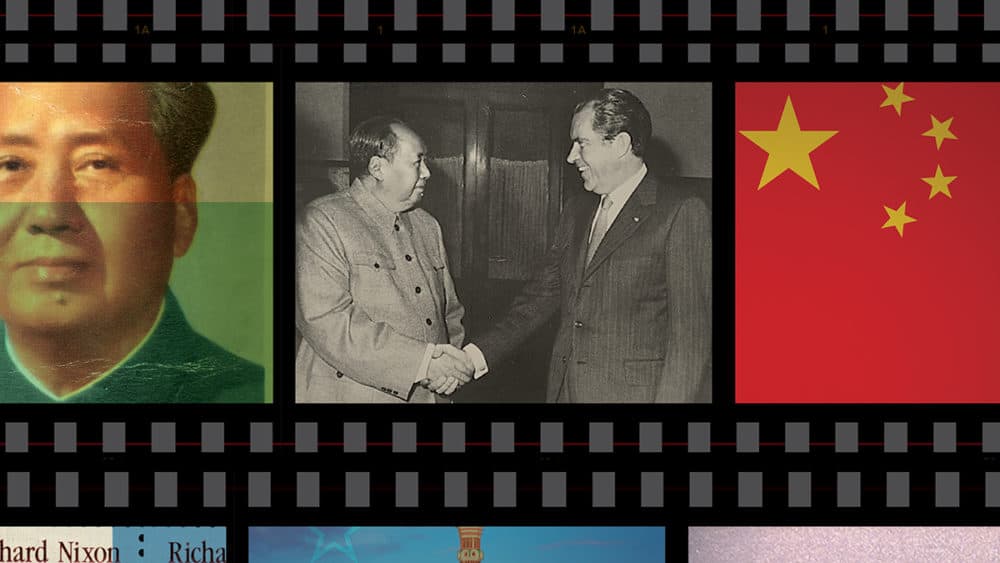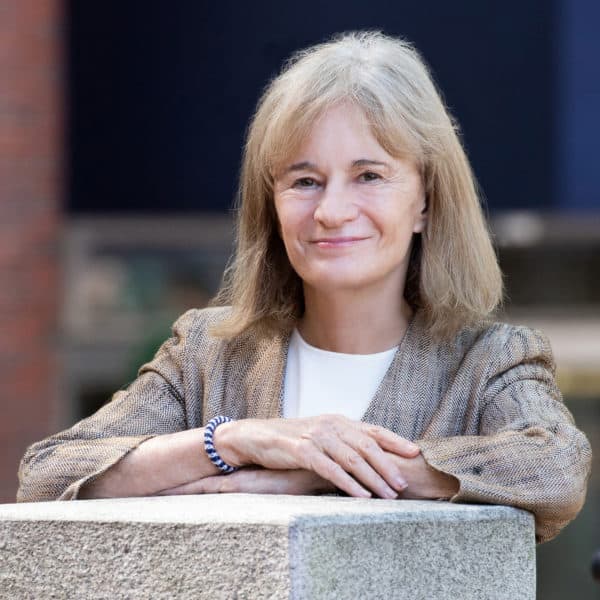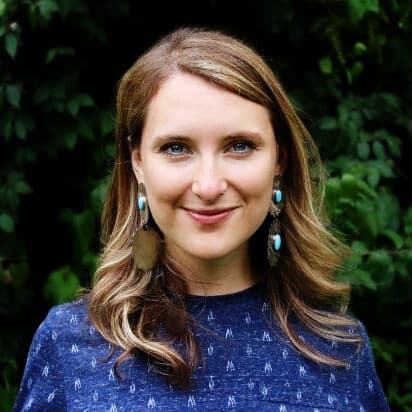Advertisement
The Great Wager
Grip and grin: When Nixon met Mao

This is Part III of The Great Wager. Click here for all five episodes.
Richard Nixon was alone in his hotel room in Beijing, uncertain and on edge.
He had traveled halfway around the world, and he still didn’t know if he would meet China's leader, Mao Zedong.
The main purpose of the trip was for China and the United States to become friends, for each man to judge the other. Nixon needed Mao's stamp of approval.
He was sitting in his room, alone and undressed, about to take a shower after the long journey.
“I had actually taken off my clothes, and was sitting in my shorts, prior to taking a shower,” Nixon would later tell his former aide Frank Gannon in an interview, “when Henry [Kissinger] came in, again rather breathless, and said, ‘Mao wants to see you right away!’ ”
President Nixon dressed and was whisked away, accompanied by only two aides, including Kissinger – and no Secret Service agents.
This dumbfounded the rest of his team. Bob Haldeman, Nixon's chief of staff, wrote in his diary, “You wonder what's going on when you have the Red Army surrounding the president.”
Why China? Why now?
This was in February 1972, but Nixon had been planning for the moment since he took office in 1969.
Nixon saw this as a history-changing trip that would ease the tensions in the Cold War, all the while keeping the U.S. the global superpower.
Beijing had just had a major victory that placed them back into the international fold: The Communist government was welcomed into the United Nations, and Taiwan, the island off of China that wanted to stay separate from the Communists, was kicked out.
On the plane ride over, Nixon got out his yellow pads and made hand-scrawled notes about similarities between himself and Mao, including that they both hate intellectuals.
When the Ethiopian Emperor Haile Selassie landed in Beijing earlier that year, he attracted huge crowds at the airport. But for Nixon, the airport was empty, save for an honor guard. When Air Force One landed in Beijing on that cold February morning, the pilot radioed to an American Secret Service agent on the tarmac, “Do not see any crowds.”
Advertisement
The Americans didn’t know it, but Mao was actually gravely ill. He suffered from a severe heart condition. His brain wasn’t getting enough oxygen. A month earlier, his pulse stopped.
While Nixon was sitting in his shorts, unsure of whether or not he'd meet Mao, the Chinese were scrambling to make sure the chairman looked as presentable as possible.
Mao's doctors eased him out of his bathrobe. They stuffed his bloated body into a new suit. They trimmed his hair. Mao practiced getting up and sitting down from his big, puffy armchair with the help of the two young nurses who took care of him. They hid oxygen tanks and a respirator in the furniture and behind the potted plants.
Finally, they were ready.
Mao’s doctor paced up and down the corridor as Nixon entered the room.
Nixon would later recall their meeting.
“Mao, in that self-deprecating way of his, said, ‘You know, sometimes I think people like me sound like big empty cannons. We talk about overthrowing everybody, we will overthrow the imperialists, we will overthrow the capitalists.’ [Mao] said, ‘After all, if we overthrow everyone, we’re not going to have friends left. So sometimes, we have to get along with the rightists.’ That, of course, meant us.”
Both sides considered the meeting a success. Mao was giving the Americans his stamp of approval, which was what they wanted. And Mao got something huge in return: Nixon — an ardent anti-Communist and arguably the most powerful man in the world — gave the Communist government in China his blessing, giving it legitimacy that it has long strived for.
Hung Huang was a child at the time. Her mother was an interpreter for Mao. She remembered the public reaction to the meeting between the leaders. People thought it was fantastic.
"Not so much fantastic that it’s great, but fantastic that it’s unimaginable; that China and America would actually have a normalized relationship,” she said. “But we also thought about it as fantastic as great, because it’s almost like China discovering a new world.”
Minxin Pei, a professor of government at Claremont McKenna College, was also still in school and read about the new relationship in The People's Daily, an official newspaper of the Chinese Communist Party. Front and center, there was a picture of a fragile-looking Mao shaking Nixon's hand.
“Up to that point, China was really isolated,” Pei said. “And now you have the world's superpower coming, knocking on your door, showing a lot of goodwill. That must be a sign that China is being recognized for its status in the world.”
Americans were watching, too. Every beat was discussed on television.
China was instantly fashionable. Fancy New York restaurants served what the Americans are eating in Beijing. News channels even hired China experts to demonstrate on-air how to use chopsticks.
A grand celebration
After Nixon and Mao met, the Chinese hosted the Americans for a banquet at the Great Hall of the People, a huge, ornate building given to the Chinese by the Soviets in the 1950s.
Nicholas Platt, a State Department diplomat who specialized in China, was there. He'd studied China for years, but because of the bad relations, he never expected he'd actually be able to travel there.
“Those of us in the press and in the State Department felt so slightly giddy,” he said. “The Great Hall was graced by an orchestra of [People’s Liberation Army] folk dressed in their floppy costumes in those days, and they were playing an absolutely magnificent version of ‘Turkey in the Straw.’ And I guess that was supposed to make us feel comfortable. And it did.”
Nixon was jubilant, toasting others with a glass full of Chinese liquor.
There was a sense of camaraderie. But, there were also more somber reminders of how different the countries are. Like Mao, a lot of the Chinese leadership was elderly and in very poor health. The dictatorship had controlled China for two decades with very little change.
“People at our table said, ‘Well, you're all so young,’” Platt said. “And I said to myself, ‘Well, I'm young.’ I was 36 at the time. But the others were not. And that hit me with a big bang, to the effect that in fact, there had been, with the exception of political purges, no change in the leadership at any level, and that the body politic was stuck.”
Striking an agreement
There were still four days left in the trip and a lot to be settled. What would the relationship be between the two countries? What would happen with Taiwan? All of this will be codified in The Shanghai Communiqué.
Nixon went sightseeing, including to the Great Wall. (He told reporters, “I think that you would have to conclude that this is a great wall, and it had to be built by great people.”)
Kissinger engaged in the details, hashing out an agreement that was supposed to outline the foundations of the new relationship.
But there was a last-minute hitch that threw the Communiqué into question. State Department diplomats insisted that Kissinger gave away too much on Taiwan, the island off China that the U.S. had pledged to defend against the Communist party.
Nixon was furious. If the two countries failed to come to an agreement, the trip would just be a historical footnote. He wanted it to be the beginning of a lasting relationship.
At the last minute, they made a provision that left the future of Taiwan ambiguous, a problem that reverberates today.
The decision to agree to disagree allowed Nixon to finally celebrate. He threw a 3 a.m. presidential suite shindig, to which diplomat Platt was invited. Platt had never been so close to the president, who was wearing a flowered dressing gown over his suit.
“Nothing unusual about it,” Platt said, “but not what heads of state usually wear when convening a meeting.”
In one hand, Platt remembered, Nixon held a cigar; in the other, a scotch and soda.
“[He] put a flowered arm around my shoulders,” Platt said. “And said, ‘From now on, you China boys are going to have a lot more and more to do.’”
And indeed they would. The two countries would go on to forge a collaboration on sensitive issues of intelligence. Within a decade, they were sharing national security secrets — and spies.
Show notes
Want to know more? Here are some of the resources The Great Wager team consulted during reporting and production.
State Department memos
The National Archives
Oral histories
Books
- Albertazzie, Ralph, and terHost, Jerald. “The Flying White House: The Story of Air Force One.” Coward, McCann & Geoghagan, 1979.
- Chen, Jian. “Mao’s China and The Cold War.” The University North Carolina Press, 2001.
- Freeman, Chas. “Interesting Times: China, America, and the Shifting Balance of Prestige.” Just World Books, 2013.
- Hersh, Seymour M. “The Price of Power: Kissinger in the Nixon White House.” Simon and Schuster, 1983.
- Holdridge, John H. “Crossing The Divide.” Rowman and Littlefield, 1997. (Episode 2 and 3)
- Isaacson, Walter. “Kissinger: A Biography.” Simon & Schuster, 1992.
- Kissinger, Henry. “White House Years.” Simon & Schuster, 2011.
- Li Zhisui. “The Private Life of Chairman Mao.” Random House, 1996.
- Macmillan, Margaret. “Nixon and Mao: The Week That Changed The World.” Random House, 2008.
- Mann, James. “About Face: A History of America's Curious Relationship with China, from Nixon to Clinton.” Alfred A. Knopf, 2000.
- Nixon, Richard. “RN: The Memoirs of Richard Nixon.” Grosset & Dunlap, 1978.
- Pomfret, John. “The Beautiful Country and the Middle Kingdom: America and China, 1776 to Present.” Henry Holt and Co., 2016.
- Platt, Nicholas. “China Boys: How U.S. Relations with the PRC Began and Grew. a Personal Memoir (ADST-DACOR Diplomats and Diplomacy).” VELLUM, 2010.
- Tudda, Chris. “Cold War Turning Point. Nixon and China 1969 - 72.” Louisiana State University Press.
- Tyler, Patrick. “A Great Wall: Six Presidents and China.” Public Affairs, 2000.
- Xia, Yafeng. “Negotiating with the Enemy.” Indiana University Press, 2006.
Documentaries
- “History Declassified: Nixon in China.” National Security Archive, 2004
- “Nixon in China.” Compilation of Audiovisual Materials, Richard Nixon Presidential Library. 2012
- “Nixon’s China Game.” PBS. 2000.
- “Playing The China Card.” Brook Lapping TV Series. 1999.
- “Looking Back on 1972: The Diary of Nixon’s Visit to China.” Phoenix TV. 2012.
The Great Wager was reported by Jane Perlez and produced by Grace Tatter. Special thanks to The Belfer Center, The John F. Kennedy School of Government, Harvard University; Luz Ding, researcher; William Burr and the National Security Archive; Susan R. Johnson, Association for Diplomatic Studies and Training; Ryan Pettigrew, the Richard Nixon Presidential Library; Lucas Nichter, Texas A&M University; Roger Lewis at Ground Zero Books; Jane Perlez’s colleagues in the Beijing bureau of The New York Times; Chas Freeman; Fredrik Logevall, Harvard University; Amb. Winston Lord; Patrick Tyler, journalist and author; and author James Mann.
This project is funded in part by a grant from the Henry Luce Foundation.
The Great Wager series collage artwork is created by WBUR. Images used are from www.archives.gov, www.alamy.com and www.istock.com. Photo credits: iStock.com: mphillips007/ Ensup / bndart / traveler1116 / sinopics / andDraw / Kateywhat. alamy.com: The Color Archives / Shim Harno / 360b / INTERFOTO. National Archives: 194412 / 194759
This segment aired on February 18, 2022.

